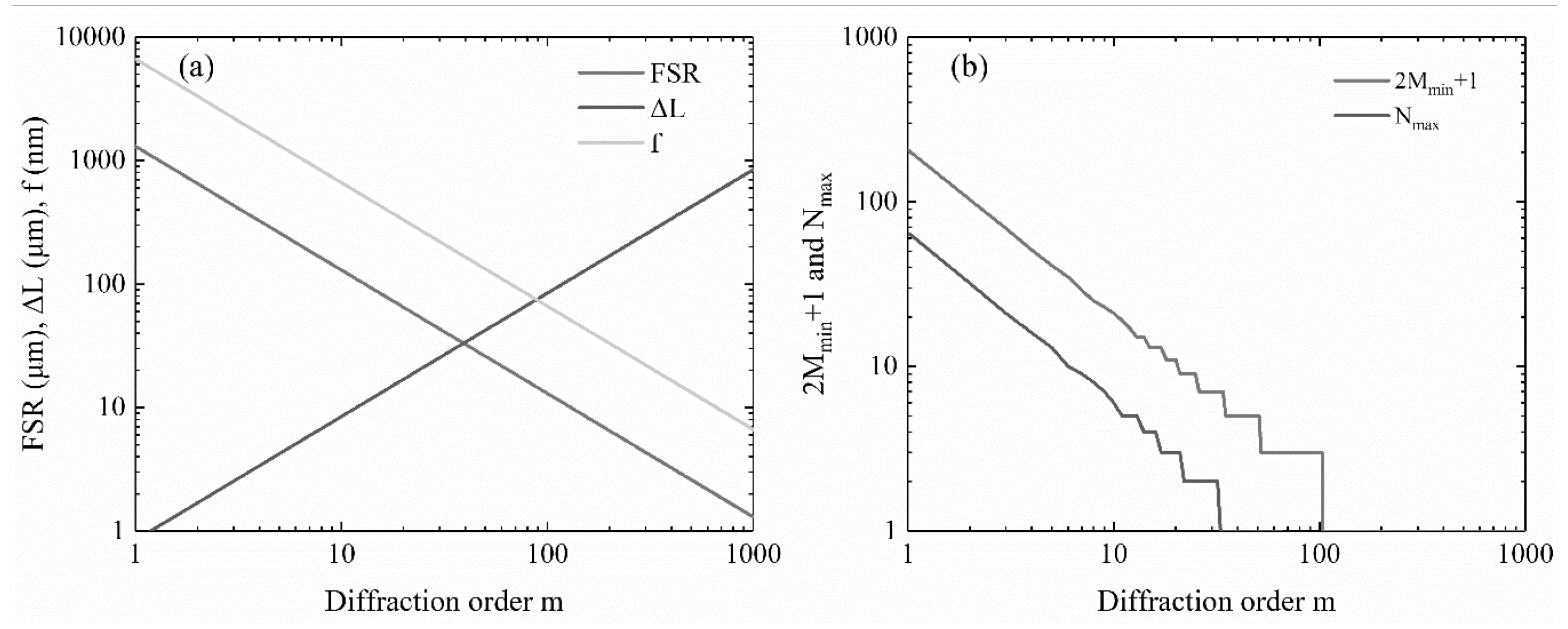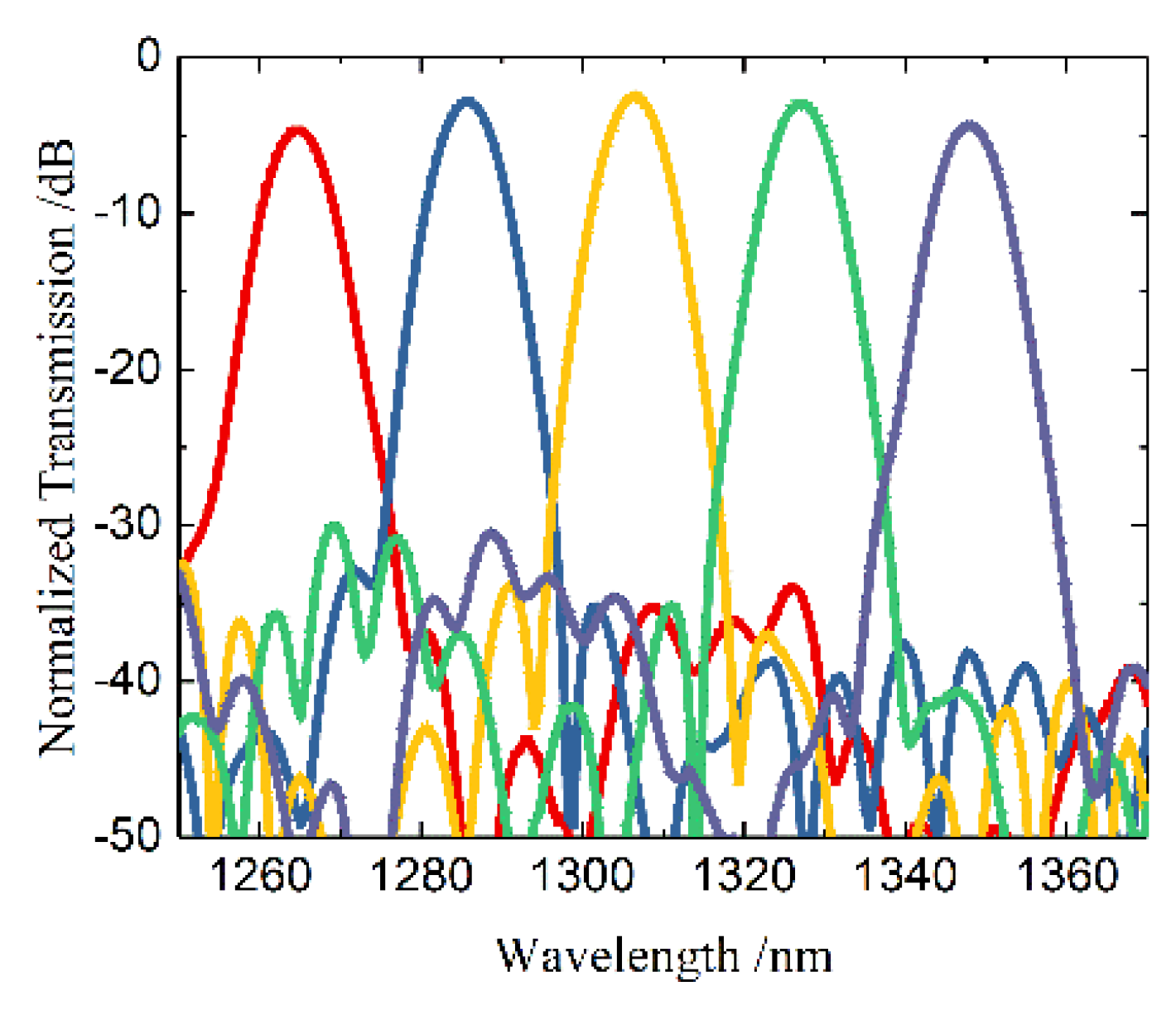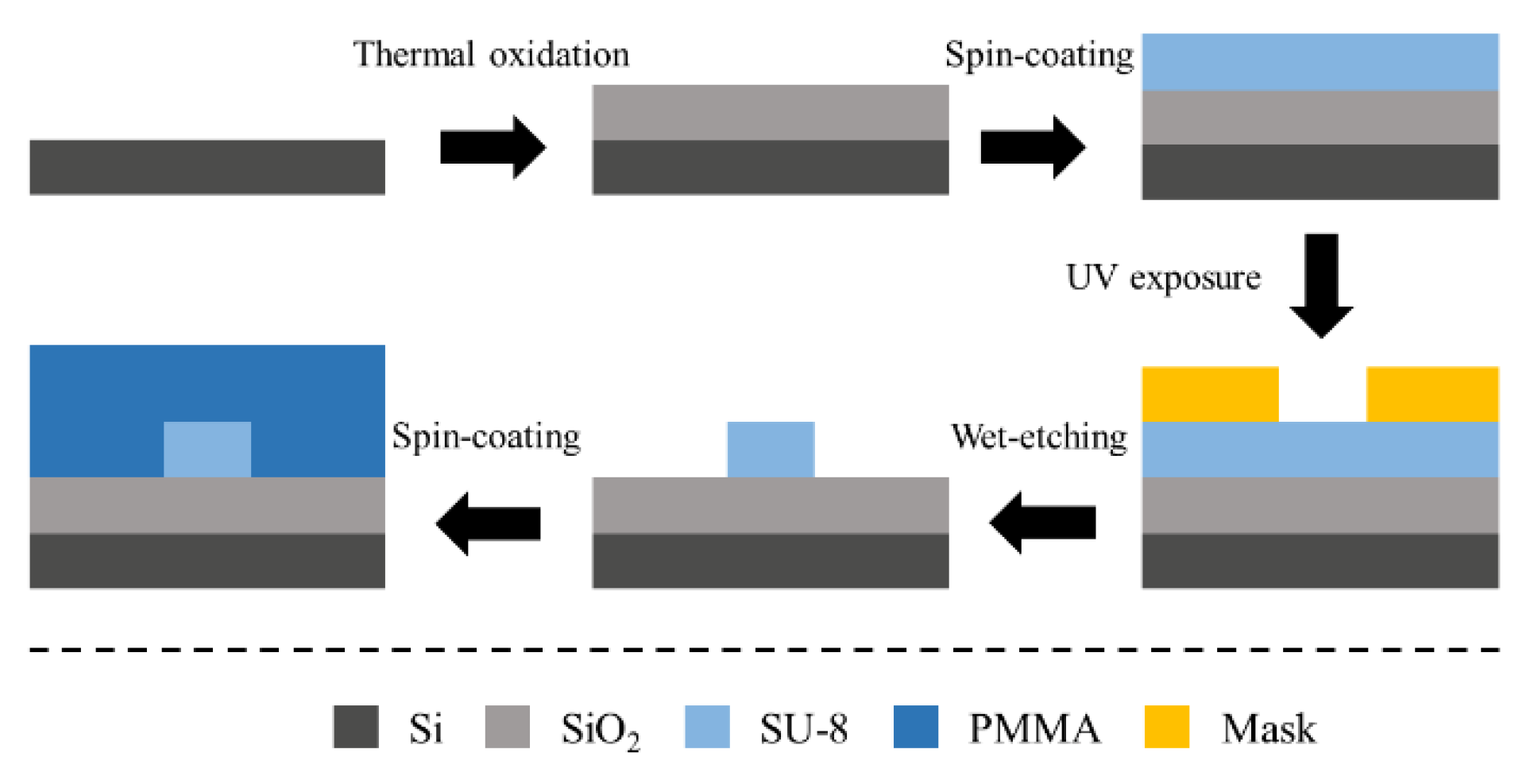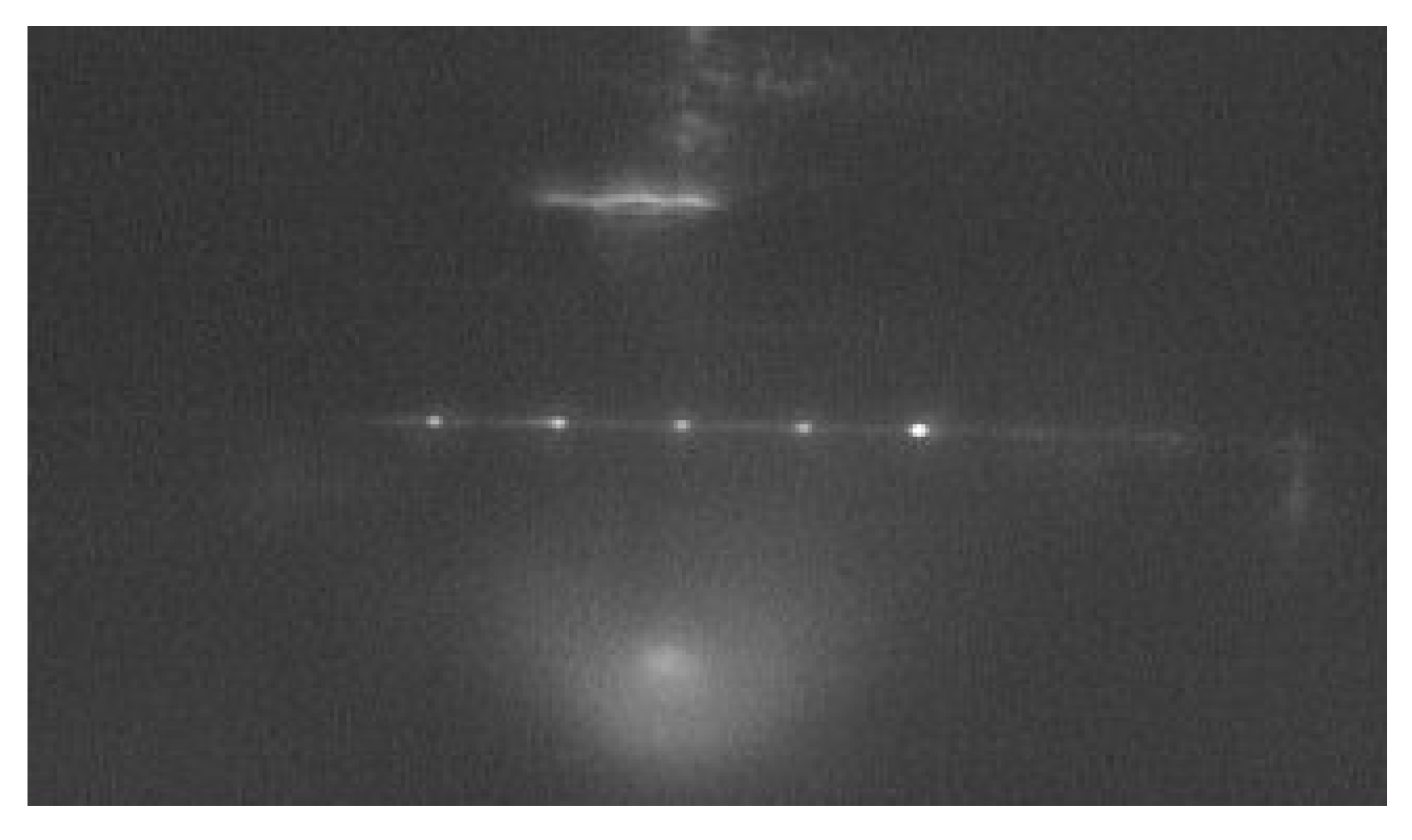5-Channel Polymer/Silica Hybrid Arrayed Waveguide Grating
Abstract
1. Introduction
2. Device Design and Simulation
3. Device Fabrication and Characterization
4. Conclusions
Author Contributions
Funding
Conflicts of Interest
References
- Banerjee, A.; Park, Y.; Clarke, F.; Song, H.; Yang, S.; Kramer, G.; Kim, K.; Mukherjee, B. Wavelength-division-multiplexed passive optical network (WDM-PON) technologies for broadband access: a review [Invited]. J. Opt. Netw. 2005, 4, 737–758. [Google Scholar] [CrossRef]
- Chang, F. Datacenter Connectivity Technologies: Principles and Practice; River Publisher: Gistrup, Denmark, 2018; pp. 4–26, 87–90. [Google Scholar]
- Jiang, G.; Baig, S.; Lu, H.; Shen, K.; Wang, M.R. Planar concave grating wavelength demultiplexers with flattened spectral response based on SU-8 polymer waveguides. Opt. Eng. 2016, 55, 037104. [Google Scholar] [CrossRef]
- Dai, D. Silicon Nanophotonic Integrated Devices for On-Chip Multiplexing and Switching. J. Lightwave Technol. 2017, 35, 572–587. [Google Scholar] [CrossRef]
- Dumon, P.; Bogaerts, W.; Thourhout, D.V.; Taillaert, D.; Baets, R.; Wouters, J.; Beckx, S.; Jaenen, P. Compact wavelength router based on a Silicon-on-insulator arrayed waveguide grating pigtailed to a fiber array. Opt. Express 2006, 14, 664–669. [Google Scholar] [CrossRef] [PubMed]
- Li, C.Y.; An, J.M.; Zhang, J.Z.; Wang, L.L.; Li, J.G.; Wang, Y.; Yin, X.J.; Wang, H.J.; Wu, Y.D. 4×20 GHz silica-based AWG hybrid integrated receiver optical sub-assemblies. Chin. Opt. Lett. 2018, 16, 060603. [Google Scholar]
- Nishi, H.; Tsuchizawa, T.; Kou, R.; Shinojima, H.; Yamada, T.; Kimura, H.; Ishikawa, Y.; Wada, K.; Yamada, K. Monolithic integration of a silica AWG and Ge photodiodes on Si photonic platform for one-chip WDM receiver. Opt. Express 2012, 20, 9312–9321. [Google Scholar] [CrossRef] [PubMed]
- Chen, C.M.; Wang, H.; Wang, L.; Sun, X.Q.; Wang, F.; Zhang, D.M. Athermal polarization-independent 49-channel UV curable all-polymer arrayed waveguide grating (AWG) multiplexer. Optik 2014, 125, 521–525. [Google Scholar] [CrossRef]
- Orghici, R.; Bethmann, K.; Zywietz, U.; Reinhardt, C.; Schade, W. All-polymer arrayed waveguide grating at 850 nm: design, fabrication, and characterization. Opt. Lett. 2016, 41, 3940–3943. [Google Scholar] [CrossRef]
- Ahn, J.T.; Park, S.; Do, J.Y.; Lee, J.M.; Lee, M.H.; Kim, K.H. Polymer Wavelength Channel Selector Composed of Electrooptic Polymer Switch Array and Two Polymer Arrayed Waveguide Gratings. IEEE Photonics Technol. Lett. 2004, 16, 1567–1569. [Google Scholar] [CrossRef]
- Lin, Y.; Rahmanian, N.; Kim, S.; Nordin, G.P.; Topping, C.; Smith, D.W.; Ballato, J. Ultracompact AWG Using Air-Trench Bends With Perfluorocyclobutyl Polymer Waveguides. J. Lightwave Technol. 2008, 26, 3062–3070. [Google Scholar] [CrossRef][Green Version]
- Li, C.Y.; An, J.M.; Wang, J.Q.; Wang, L.L.; Zhang, J.S.; Li, J.G.; Wu, Y.D.; Wang, Y.; Yin, X.J.; Li, Y.; et al. The 8×10 GHz Receiver Optical Subassembly Based on Silica Hybrid Integration Technology for Data Center Interconnection. Chin. Opt. Lett. 2017, 34, 104202. [Google Scholar] [CrossRef]
- Ren, M.Z.; Zhang, J.S.; An, J.M.; Wang, Y.; Wang, L.L.; Li, J.G.; Wu, Y.D.; Yin, X.J.; Hu, X.W. Low power consumption 4-channel variable optical attenuator array based on planar lightwave circuit technique. Chin. Phys. B 2017, 26, 074221. [Google Scholar] [CrossRef]
- Wang, L.L.; An, J.M.; Zhang, J.S.; Wu, Y.D.; Li, J.G.; Yin, X.J.; Wang, H.J.; Wang, Y.; Zhong, F.; Zha, Q.; et al. Design and fabrication of a low-loss and asymmetric 1 x 5 arbitrary optical power splitter. Appl. Opt. 2016, 55, 8601–8605. [Google Scholar] [CrossRef] [PubMed]
- Maria, N.; Dan, A.Z.; Anja, B.; Jörg, H. Single-Mode Waveguide With SU-8 Polymer Core and Cladding for MOEMS Applications. J. Lightwave Technol. 2007, 25, 1284–1289. [Google Scholar]
- Yu, X.; Gregory, P.; Zhang, Y.M.; Paddy, F. Single-Mode Tapered Vertical SU-8 Waveguide Fabricated by E-Beam Lithography for Analyte Sensing. Sensors 2019, 19, 3383. [Google Scholar]
- Wang, X.B.; Sun, J.; Chen, C.M.; Sun, X.Q.; Wang, F.; Zhang, D.M. Thermal UV treatment on SU-8 polymer for integrated optics. Opt. Mater. Express 2014, 4, 509. [Google Scholar] [CrossRef]
- Han, X.Y.; Wu, Z.L.; Yang, S.C.; Shen, F.F.; Liang, Y.X.; Wang, L.H.; Wang, J.Y.; Ren, J.; Jia, L.Y.; Zhang, H.; et al. Recent Progress of Imprinted Polymer Photonic Waveguide Devices and Applications. Polymers 2018, 10, 603. [Google Scholar] [CrossRef]
- Tian, L.; Wang, F.; Wu, Y.D.; Sun, X.Q.; Yi, Y.J.; Zhang, D.M. Polymer/silica hybrid integration waveguide Bragg grating based on surface plasmon polaritons. Appl. Opt. 2018, 57, 3607–3611. [Google Scholar] [CrossRef]
- Tian, L.; Wang, F.; Wu, Y.D.; Yi, Y.J.; Sun, X.Q.; Zhang, D.M. Polymer/silica hybrid integration add-drop filter based on grating-assisted contradirectional coupler. Opt. Lett. 2018, 43, 2348–2351. [Google Scholar] [CrossRef]
- Yin, Y.X.; Wu, Z.F.; Sun, S.W.; Tian, L.; Wang, X.B.; Wu, Y.D.; Zhang, D.M. Multi-functional optical fiber sensor system based on a dense wavelength division multiplexer. Chin. Phys. B 2019, 28, 074202. [Google Scholar] [CrossRef]
- Kim, B.K.; Joo, K.N. A multi-channel fiber optic proximity sensor. Meas. Sci. Technol. 2016, 27, 035104. [Google Scholar] [CrossRef]
- Kao, H.Y.; Su, Z.X.; Shih, H.S.; Chi, Y.C.; Tsai, C.T.; Kuo, H.C.; Wu, C.H.; Jou, J.J.; Shih, T.T.; Lin, G.R. CWDM DFBLD Transmitter Module for 10-km Interdata Center With Single-Channel 50-Gbit/s PAM-4 and 62-Gbit/s QAM-OFDM. J. Lightwave Technol. 2018, 36, 703–711. [Google Scholar] [CrossRef]
- Guerber, S.; Alonso-Ramos, C.; Perez-Galacho, D.; Roux, X.L.; Vulliet, N.; Cremer, S.; Marris-Morini, D.; Boeuf, F.; Vivien, L.; Baudot, C. Design and integration of an O-band silicon nitride AWG for CWDM applications. In Proceedings of the IEEE 14th International Conference on Group IV Photonics, Berlin, Germany, 23–25 August 2017; pp. 133–134. [Google Scholar]
- Lu, S.; Yang, C.; Yan, Y.; Jin, G.; Zhou, Z.; Wong, W.H.; Pun, E.Y.B. Design and fabrication of a polymeric flat focal field arrayed waveguide grating. Opt. Express 2005, 13, 9982. [Google Scholar] [CrossRef] [PubMed]
- Jack, S.K.; Daniel, P.P.; Pavel, N.; Levent, Y.; Yu, C. Design and fabrication of Poly(dimethylsiloxane) arrayed waveguide grating. Opt. Express 2010, 18, 21732. [Google Scholar]
- Tung, K.K.; Wong, W.H.; Pun, E.Y.B. Polymeric optical waveguides using direct ultraviolet photolithography process. Appl. Phys. A 2005, 80, 621–626. [Google Scholar] [CrossRef]
- Lee, K.Y.; LaBianca, N.; Rishton, S.A. Micromachining applications of a high resolution ultrathick photoresist. J. Vac. Sci. Technol. B 1995, 13, 3012. [Google Scholar] [CrossRef]
- Guo, W.B.; Ma, C.S.; Zhang, D.M.; Chen, K.X.; Zhao, Y.; Cui, Z.C.; Liu, S.Y. Parameter optimization and structural design of polymer arrayed waveguide grating multiplexer. Opt. Commun. 2002, 201, 45–53. [Google Scholar] [CrossRef]







| Number of Channels | 5 |
|---|---|
| Central Wavelength (nm) | 1311 |
| Channel Spacing (nm) | 20 |
| Core Size (μm2) | |
| Free Spectral Range (nm) | 118.18 |
| Diffraction Order | 11 |
| Orientation Angle (deg) | 30 |
| Spacing of Arrayed and Input/Output Waveguides (μm) | 9.25 |
| Path Length Difference ∆L (μm) | 9.30 |
| Number of Arrayed Waveguide | 25 |
© 2020 by the authors. Licensee MDPI, Basel, Switzerland. This article is an open access article distributed under the terms and conditions of the Creative Commons Attribution (CC BY) license (http://creativecommons.org/licenses/by/4.0/).
Share and Cite
Zhang, S.-R.; Yin, Y.-X.; Lv, Z.-Y.; Gao, D.-S.; Wang, X.-B. 5-Channel Polymer/Silica Hybrid Arrayed Waveguide Grating. Polymers 2020, 12, 629. https://doi.org/10.3390/polym12030629
Zhang S-R, Yin Y-X, Lv Z-Y, Gao D-S, Wang X-B. 5-Channel Polymer/Silica Hybrid Arrayed Waveguide Grating. Polymers. 2020; 12(3):629. https://doi.org/10.3390/polym12030629
Chicago/Turabian StyleZhang, Sheng-Rui, Yue-Xin Yin, Zi-Yue Lv, Ding-Shan Gao, and Xi-Bin Wang. 2020. "5-Channel Polymer/Silica Hybrid Arrayed Waveguide Grating" Polymers 12, no. 3: 629. https://doi.org/10.3390/polym12030629
APA StyleZhang, S.-R., Yin, Y.-X., Lv, Z.-Y., Gao, D.-S., & Wang, X.-B. (2020). 5-Channel Polymer/Silica Hybrid Arrayed Waveguide Grating. Polymers, 12(3), 629. https://doi.org/10.3390/polym12030629






